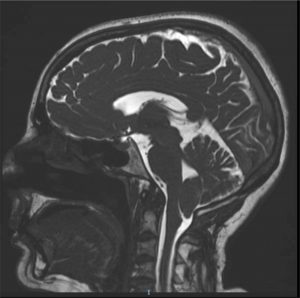Chiari malformation is a disorder characterised by part of the cerebellum (Cerebellar Tonsils) spreading through the greater occipital opening (Foramen Magnum). This opening is only for the part lower of the trunk and the spinal cord but as it is also occupied by part of the brain tissue, this causes compression of these structures and hinders free circulation of cerebrospinal fluid (Hydrocephalus and syringomyelia).
The symptoms it causes are by compression and the most common ones are: headache, normally located in the back of the head that worsens with effort, dizziness, nausea, vomiting, instability, sensory and motor disorders. Depending on the degree of progress there may only be headache (main symptom) or all the others combined.
Diagnosis requires cerebral and cervical magnetic resonance to detect invasion of part of the cerebellum through the foramen magnum. Depending on the symptoms and possible associated diseases other complementary studies may be required: Evoked potentials, holomedullary MRI, telemetric radiographs, etc.
Treatment will depend on the assessment of a specialised neurosurgeon who will evaluate the clinical signs and additional tests (resonance) carried out on the patient. In general, as it is a disorder caused by the compression of different structures, if a surgical operation is necessary, it is designed to decompress the nerve structures of the area and achieve improvement or resolution of the symptoms.



